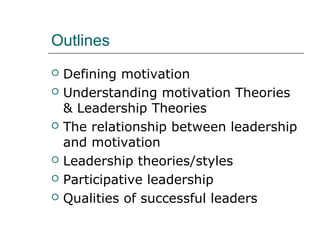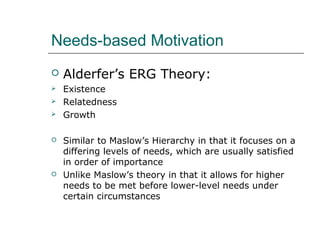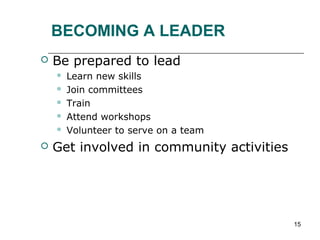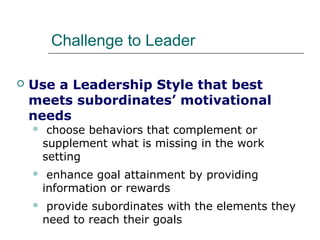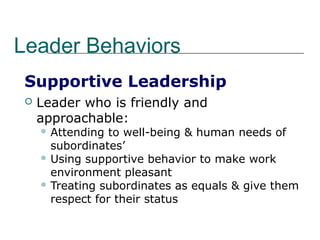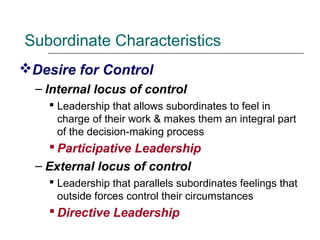Motivation & The Act of Leading
- 1. 1 MOTIVATION,& THE ACT OF LEADING Daw Winne Tun Dept. of Management Studies September,2015
- 2. Outlines Defining motivation Understanding motivation Theories & Leadership Theories The relationship between leadership and motivation Leadership theories/styles Participative leadership Qualities of successful leaders
- 3. 3 MOTIVATION Motivation: an internal drive that causes people to behave in a certain way to meet a need Motivation comes from within There are several factors that contribute to motivation (not just monetary)
- 4. 4 TALK IT OUT What motivates you at work or at school?
- 5. 5 MOTIVATION Only you can motivate you Others can only provide a motivating environment When having an nonproductive day Use self-talk and your goals to get back on track
- 6. What is motivation? Motivation is defined as “the extent to which persistent effort is directed toward a goal” 1. Effort - must be defined in relation to its appropriateness to the objectives being pursued. 2. Persistence - relates to the willingness of the individual to stay with a task until it is complete 3. Direction - measured in terms of how persistent effort is applied in relation to the goals being pursued 4. Goals - individual goals and organizational goals (must be compatible)
- 7. Types of motivation Extrinsic Motivation - Factors in the external environment such as pay, supervision, benefits, and job perks Intrinsic Motivation - Relationship between the worker and the task
- 8. Needs-based Motivation Maslow’s Hierarchy of Needs: Physiological Safety Relationship Esteem Self-actualization The more you move from basic to higher level needs, the more motivation depends on internal factors Important that organizations present opportunities to satisfy such needs
- 9. 9 MOTIVATION Maslow in the Workplace Physiological—Basic Wages Safety—Job Security/Environment Social—Informal Groups Esteem—Recognition/Respect Self-actualization—Expand Skills Figure 11-1
- 10. Needs-based Motivation Alderfer’s ERG Theory: Existence Relatedness Growth Similar to Maslow’s Hierarchy in that it focuses on a differing levels of needs, which are usually satisfied in order of importance Unlike Maslow’s theory in that it allows for higher needs to be met before lower-level needs under certain circumstances
- 11. Needs-based Motivation McClelland’s Theory of Needs: Achievement Affiliation Power Concerned with the behavioral consequences of need Non-hierarchical
- 12. 12 MOTIVATION McClelland’s Theory of Needs Achievement Power Affiliation Victor Vroom’s Expectancy Theory Behavior based on outcome
- 13. Needs-based Motivation These three theories present a useful approach for thinking about organizational behavior One is not inherently better than the other; The point is to apply the concepts of internal/external motivation to individual situations
- 14. Leadership Once it is known what motivates people, leadership can be thought of in relation to individual situations Two main types of leaders: Emergent Assigned
- 15. 15 BECOMING A LEADER Be prepared to lead Learn new skills Join committees Train Attend workshops Volunteer to serve on a team Get involved in community activities
- 16. May 2, 2006 LIS580- Spring 2006 16 Managers Versus Leaders “Not all leaders are managers, nor are all managers leaders” Managers Persons whose influence on others is limited to the appointed managerial authority of their positions Leaders Persons with managerial and personal power who can influence others to perform actions beyond those that could be dictated by those persons’ formal (position) authority alone Prentice Hall, 2002
- 17. May 2, 2006 LIS580- Spring 2006 17 Power and Leadership Legitimate Sources of Power Position in the organization (formal authority) Reward Coerce or punish Expertise Referent power (charisma) Control over information or access to resources (gatekeeper) What does Kitchen say about power? G.Dessler, 2003
- 18. 18 LEADERSHIP Leadership: the process of one person guiding (influencing) one or more individuals toward a specific goal We are all leaders Leaders are not just managers and supervisors Not all bosses are leaders
- 19. May 2, 2006 LIS580- Spring 2006 19 Transactional versus Transformational Leadership Behaviors Transactional Leadership Behaviors Leadership actions that focus on accomplishing the tasks at hand and on maintaining good working relationships by exchanging promises of rewards for performance. G.Dessler, 2003
- 20. May 2, 2006 LIS580- Spring 2006 20 Transactional versus Transformational Leadership Behaviors Transformational Leadership Behaviors Leadership actions that involve influencing major changes in the attitudes and assumptions of organization members and building commitment for the organization’s mission, objectives, and strategies. G.Dessler, 2003
- 21. 21 LEADERSHIP Primary leadership styles: Autocratic leaders: authoritarian, they make decisions on their own Democratic leaders: make decisions based upon input from others Laissez-faire leaders: allow team members to make their own decisions without input from the leader
- 22. 22 TALK IT OUT If the room was on fire, how would each type of leader direct his or her employees?
- 23. Challenge to Leader Use a Leadership Style that best meets subordinates’ motivational needs choose behaviors that complement or supplement what is missing in the work setting enhance goal attainment by providing information or rewards provide subordinates with the elements they need to reach their goals
- 24. Conditions of Leadership Motivation It increases the number and kinds of payoffs subordinates receive from their work Makes the path to the goal clear and easy to travel through with coaching and direction Removes obstacles and roadblocks to attaining the goal Makes the work itself more personally satisfying Leadership generates motivation when:
- 25. 25 LEADERSHIP Effective leaders display characteristics that make them stand out Work well with others Trustworthy Ethical Focused Visionaries Excellent communication
- 26. Leadership Styles Directive - includes scheduling work, maintaining performance standards, and letting subordinates know what is expected from them Supportive - friendly, approachable, and concerned with pleasant interpersonal relationships.
- 27. Leadership Styles Participative – leaders will consult with their subordinates, and consider their opinions. Achievement-oriented - encourages subordinates to exert higher efforts and strive for a higher level of goal accomplishment.
- 28. LLeader Behaviors Directive Leadership Leader who gives subordinates task instruction including: What is expected of them How task is to be done Timeline for task completion Clear standards of performance Clear rules & regulations
- 29. Leader Behaviors Supportive Leadership Leader who is friendly and approachable: Attending to well-being & human needs of subordinates’ Using supportive behavior to make work environment pleasant Treating subordinates as equals & give them respect for their status
- 30. Leader Behaviors Participative Leadership Leader who invites subordinates to share in the decision-making: Consults with subordinates Seeks their ideas & opinions Integrates their input into group/organizational decisions
- 31. Participative Leadership Has a wide range of applications – Can have total involvement of subordinates in implementation, planning, etc. Possible benefits of participation: Motivation Quality Acceptance
- 32. Participative Leadership Possible Pitfalls Requires a lot of time and energy Resentment Best to use this style when employees are part of a team for an extended period and are knowledgeable/proficient
- 33. Leader Behaviors Achievement Oriented Leadership Leader who challenges subordinates to perform work at the highest level possible: Establishes a high standard of excellence for subordinates Seeks continuous improvement Demonstrates a high degree of confidence in subordinates’ ability to establish & achieve challenging goals
- 34. Situational Factors 2 major situational factors affecting leader success: Subordinate Characteristics – aptitude, individual needs Environmental factors – task urgency, clarity, appropriateness of leader’s style to the situation, timing
- 35. Subordinate Characteristics Strong need for affiliation – Friendly and concerned leadership is a source of satisfaction – Supportive Leadership Preference for Structure – Dogmatic & authoritarian Leadership provides psychological structure, task clarity & greater sense of certainty in work setting – Directive Leadership
- 36. Subordinate Characteristics Desire for Control – Internal locus of control Leadership that allows subordinates to feel in charge of their work & makes them an integral part of the decision-making process Participative Leadership – External locus of control Leadership that parallels subordinates feelings that outside forces control their circumstances Directive Leadership
- 37. Subordinate Characteristics Perception of their own ability – specific task – As perception of ability and competence goes up, need for highly directive leadership goes down. – Directive leadership may become redundant, possibly excessively controlling
- 38. Task Characteristics ComponentsComponents Task Characteristics: – Design of subordinates’ task – Organization’s formal authority system – Primary work group of subordinates
- 39. Task Characteristics Unclear and ambiguous - Leader needs to provide structure Highly repetitive - Leader needs to provide support to maintain subordinate motivation Weak formal authority - If formal authority system is weak, the leader needs to assist subordinates by making rules and work requirements clear Nonsupportive/weak group norms - Leader needs to help build cohesiveness and role responsibility Task Situations Requiring Leader InvolvementTask Situations Requiring Leader Involvement
- 40. Task Characteristics ObstaclesObstaclesObstaclesObstacles Anything in the work setting that gets in the way of subordinates They create excessive uncertainties, frustrations, or threats for subordinates Leader’s responsibility is to help subordinates by – Removing the obstacles Helping subordinates around them Assisting with obstacles will increase Subordinates’ expectations to complete the task Their sense of job satisfaction
- 41. Qualities of Successful Leaders Intellectual Stimulation Energy Self-confidence Assertiveness Dominance Motivation Honesty and Integrity Charisma
- 42. May 2, 2006 LIS580- Spring 2006 42 How To Improve Your Leadership Skills Skill 1: Think Like a Leader Identify what is happening Explain why it is happening Decide what you are going to do about it. Skill 2: Use an Appropriate Leadership Style Leaders usually fit their style to the situation. Different leadership styles are appropriate to different situations. G.Dessler, 2003
- 43. May 2, 2006 LIS580- Spring 2006 43 How To Improve Your Leadership Skills Skill 3: Pick the Right Leadership Situation Gravitate toward leadership situations that fit your favored leadership style. Skill 4: Build Your Power Base Bolster your leadership potential by enhancing your authority (increasing your power). G.Dessler, 2003
- 44. May 2, 2006 LIS580- Spring 2006 44 How To Improve Your Leadership Skills Skill 5: Exercise Better Judgment Decisiveness and good judgment (“cognitive ability”) are important leadership traits. Skill 6: Improve Leadership Traits and Skills Exhibit self-confidence. Display honesty and integrity. Increase your knowledge of the business. G.Dessler, 2003
- 45. May 2, 2006 LIS580- Spring 2006 45 Thanks for Your Time and Attention. G.Dessler, 2003
Editor's Notes
- Motivation Motivation can be defined as “the extent to which persistent effort is directed toward a goal” (Campbell, Dunnette, Lawler &Weick). Effort: The first aspect of motivation refers to the amount of effort being applied to the job. This effort must be defined in relation to its appropriateness to the objectives being pursued. One may, for example, apply tremendous effort to inappropriate tasks that do not contribute to the achievement of the stated goals. Persistence: The second characteristic relates to the willingness of the individual to stay with a task until it is complete. For example, an important task that gets accomplished with effort but allows the person to rest on their laurels for an extended period does not display persistence. Leadership and Motivation Unit 11 3 Direction: Is the effort directed towards the organization’s goals or related to the individual’s self-interest? Direction is therefore measured in terms of how persistent effort is applied in relation to the goals being pursued. Goals: There are two different kinds of goals being pursued simultaneously. They are individual goals and organizational goals
- Maslow’s Hierarchy of Needs Abraham Maslow developed a theory that humans have five sets of needs that are arranged in a hierarchy. He contends that people start by trying to satisfy their most basic or compelling needs and progress toward the most fulfilling. These needs are as follows: 1. Physiological needs: These include the need for food, water, shelter, clothing and money. Until an individual has access to these necessities, there can be no further progress. These needs are very basic, and for the most part, society and our social network have ensured that they are present. Intrinsic values include personal comfort and satisfaction, while the extrinsic values are most often provided by the organization, the community, or society. 2. Safety needs: These include security, stability, and a structured environment. Here, the individual expects and pursues job security, a comfortable work environment, pension and Leadership and Motivation Unit 11 4 insurance plans, and freedom to organize in order to ensure continuation of these benefits. Individual’s main objective is to ensure that benefits are protected or employment needs are being met rather than contributing to long-term organizational goals. Again, we see a dependance on the external environment to provide these supports. Personal motivation may include the peace of mind that can be provided as a result of these needs being secured. 3. Relationship needs: Relationship needs include socialization, affection, love companionship, and friendship. The individual at this level participates for personal or intrinsic rewards. Since no person can live for extended periods without interaction with other people, the individual may be drawn to participate simply to fulfill this need. Organizations that provide these opportunities include social clubs, singles clubs, seniors clubs and service clubs, depending on the level of personal need. The organization can assist by ensuring that the opportunity for social and relationship expectations are created and met. 4. Esteem needs: These include feelings of adequacy, competence, independence, confidence, appreciation, and recognition by others. Again, the individual is driven more by internal or intrinsic needs. The external environment is needed more to provide recognition than to provide material rewards. At this point, the intrinsic value is more important than that which can be provided by outside influences. The ego seems to take over here and the need is to ensure that it is satisfied. 5. Self-actualization: This area is the most difficult to define and therefore, may be the most difficult to explain. Why does the successful business person need to pursue further wealth when they have already accumulated more than they will ever need? The answer may lie in the fact that motivation is more internal and therefore, even more individualistic. Different people have different ideas about what they need to achieve in order to obtain true happiness. For the wealthy person, money may no longer be the motivator, it may now be a need to exercise power or the adventure and adrenalin rush created as a result of playing “high stakes games”. This becomes the intrinsic motivation. People who pursue self-actualization are more accepting of reality, themselves, and others. Organizational requirements may include the opportunity for creativity and growth. Frequently, individuals aspiring to this level often operate outside existing organizations and instead build their own structures to suit their individual needs. In discussing this theory, it appears that the further up the scale an individual moves, the more the rewards or motivators move from the external environment to an internal need. It also becomes more difficult to influence motivation, since material rewards become less relevant and internal Leadership and Motivation Unit 11 5 rewards become more difficult to identify and address. In order to enhance organizational performance, it is important that the
- Alderfer’s ERG Theory Clayton Alderfer developed another needs-based theory that supports in many ways, the theory developed by Maslow, but consists of three rather than five basic needs. Alderfer also sees his three levels which includes existence, relatedness, and growth (ERG) needs as being hierarchical, and thus, influenced by personal growth and extrinsic and intrinsic rewards. 1. Existence needs: These include needs that are satisfied by material substances or conditions. They correspond closely to the physiological needs identified by Maslow and those safety needs that can be satisfied by material rather than interpersonal rewards or conditions. They include the need for food, shelter, pay, and safe working conditions. 2. Relatedness needs: These are needs that may be satisfied by communication, or exchange and interaction with other individuals. There is a dependance on feedback from other organizational or community members to fulfill these needs. Thus, the motivation is provided by a combination of intrinsic and extrinsic rewards. These rewards include accurate and honest feedback, which may involve direction and advice rather than unconditional pleasantness or agreement. 3. Growth needs: These are needs that are fulfilled by strong personal involvement that fully utilizes our skills, abilities, and creativity. They include Maslow’s self- actualization as well as esteem needs that rely on intrinsic rewards. Both theories are also similar because they are hierarchical, and individuals will concentrate on the achievement of the lowest level of need that is not fully satisfied. Maslow contends that the lowest level of need must be satisfied before an individual can proceed to the next higher level. Alderfer theorizes that if a higher level need is unsatisfied, the individual will regress to a desire to satisfy lower-level needs. Maslow believes that once a need is met, it is no longer motivational. Alderfer theorizes that while an individual may have met a higher-level need in one’s personal life, for example, they may still be operating much lower on the
- McClelland’s Theory of Needs Psychologist David McClelland contends that we develop a relatively stable personality early in life that, once acquired, remains unchanged. McClelland, therefore, does not see motivation as Leadership and Motivation Unit 11 6 hierarchical. He does not address the issue of growth, but has been more concerned with the behavioural consequences of need. The three areas of need he has identified include the need for achievement, the need for affiliation, and the need for power. 1. Need for achievement: Individuals in this category have a strong desire to perform challenging tasks well. They have a preference for situations where personal responsibility can be taken for successful outcomes. The goals they set provide for moderate and calculated risk, and the individual seeks performance feedback to allow for modification and to ensure success. 2. Need for affiliation: People in this category display a need to establish and maintain friendly, compatible relationships. They have a need to like other people and want others to like them. They have an ability to create social networks that will result in meeting these needs. 3. Need for power: People in this category have a strong need to have influence over others. They wish to make a significant impact and impression on those with whom they come in contact. This need for power corresponds in many ways to Maslow’s esteem needs where power is used to get attention or to build personal prestige. Since this theory is non-hierarchical, the growth pattern between intrinsic and extrinsic rewards that are a major part of the earlier theories, do not appear to contain the same significance. McClelland contends that people will be motivated to seek out and perform well in jobs that match their needs. These needs may include either of the three categories
- The testing of these three theories has resulted in some conclusions that help us identify the strengths and limitations of each approach. While Maslow’s theory is complicated and contains more steps than the others, there is recognition of the progression from one level to the other. Alderfer’s three levels seem to be simpler, less rigid, and therefore, may be more satisfactory to those who wish to understand and apply a model to individual behaviour. Results of McClelland’s research has been applied in organizational settings and have been supportive of the idea that particular needs are motivational. Our former theme, ‘when all else is consistent, the individual is different’, suggests that the application of any theory of motivation has strengths and weaknesses that allow insight into individual motivation and provide escapes for those times when the theory will let us down. All theories contribute to a better understanding of human behaviour in general, but specific application of theory depends on factors that respond to individual needs.
- Leadership In many circles, there is continuous debate about whether leaders are born or developed. If we reflect on our earlier discussion about motivation, we will see that humans are very complicated and are made up of a number of traits. As with motivation, these influences are both inherited and acquired from our environment and influences, and consequently, leadership theories will continue to be debated in the future. We will continue this discussion on the assumption that leadership can be developed. Furthermore, for the purpose of this unit, we will not distinguish between leaders and managers, but will use the term leader to apply to any earned or appointed role that carries with it the exercise of power and influence over others. Leadership may be defined as: the influence that particular individuals (leaders) exert upon the goal achievement of others (subordinates) in an organizational context. An earlier unit on Board Governance addresses in a limited way, the impacts of leaders on performance. We stated that leaders have an ability to see how different aspects of a situation fit together and influence each other. They seek out alliances, opportunities, and approach goals in a proactive way. They have a positive effect on others, which attracts support from those who have similar needs for accomplishment. Their self confidence creates a belief in other people’s abilities, therefore, emphasis is placed on empowerment and freedom. If we agree with these statements, then leadership has two distinct aspects: i) the individual who exerts influence, and ii) those who are the objects of this influence. Successful leadership depends, to a large extent, on the environment and situation in which these dynamics exist. There are other issues that must also be acknowledged. There are two types of leaders: emergent leaders - those who earn leadership positions through their expertise, skills, abilities to influence others, or personal acceptability by the group; and assigned leaders - those who are given power to exercise influence through appointment. In general terms, both emergent and assigned leaders fulfill two different functions. They must be able to provide social and emotional support to the group by listening, acknowledging, team building, and supporting other members in the group. This is referred to as social-emotional support. The second factor is to provide direction and assistance to the group in accomplishing their tasks. Successful leaders have the ability to identify and apply the appropriate strategy at the right time. A group that is confused about the goals of the organization, for example, will not respond well to a social-emotional approach, nor will a group that is experiencing internal conflict and in need of team
- House’s Path-Goal Theory According to Robert House, the most important activities of leaders are those that clarify the path to various goals of interest to subordinates, thus effective leaders form a connection between subordinate goals and organizational goals. Since leadership is about increasing group performance through motivation, the leader must be more concerned with job satisfaction and the creation of a clear picture of how subordinates can gain rewards based on performance. House’s theory is concerned with four different kinds of leader behaviour. These include: 1. Directive behaviour: This includes scheduling work, maintaining performance standards, and letting subordinates know what is expected from them. 2. Supportive behaviour: A leader displaying this behaviour is friendly, approachable, and concerned with pleasant interpersonal relationships. 3. Participative behaviour: Leaders who practice this behaviour consult with their subordinates, and consider their opinions. 4. Achievement-orientated behaviour: This behaviour encourages subordinates to exert higher efforts and strive for a higher level of goal accomplishment. Leaders demonstrating this behaviour express confidence that subordinates can reach these goals.
- House’s Path-Goal Theory According to Robert House, the most important activities of leaders are those that clarify the path to various goals of interest to subordinates, thus effective leaders form a connection between subordinate goals and organizational goals. Since leadership is about increasing group performance through motivation, the leader must be more concerned with job satisfaction and the creation of a clear picture of how subordinates can gain rewards based on performance. House’s theory is concerned with four different kinds of leader behaviour. These include: 1. Directive behaviour: This includes scheduling work, maintaining performance standards, and letting subordinates know what is expected from them. 2. Supportive behaviour: A leader displaying this behaviour is friendly, approachable, and concerned with pleasant interpersonal relationships. 3. Participative behaviour: Leaders who practice this behaviour consult with their subordinates, and consider their opinions. 4. Achievement-orientated behaviour: This behaviour encourages subordinates to exert higher efforts and strive for a higher level of goal accomplishment. Leaders demonstrating this behaviour express confidence that subordinates can reach these goals.
- Participative Leadership We have seen in an earlier unit (Public Participation) that there are differing degrees or levels of participation. These range from total involvement of subordinates in planning, implementation, and evaluation to simple requests for assistance where such participation is a necessary ingredient for success. Given this fact, we can easily see that participation will not be successful in all situations. While public or community involvement will provide much better results in compiling a strategic plan for the community, you would not apply a public participation model if you were trying to escape from a burning building. Public or community participation can contribute to the following: 1. Motivation: Participation can contribute to identifying and establishing group goals and how they can be accomplished. It can also contribute to intrinsic motivation by enriching subordinates jobs through variety, autonomy, and empowerment. 2. Quality: There is an old saying that “two heads are better than one”. In many cases this is true of participation. Subordinates have knowledge and expertise that the leader may not have, thus this combination of leader and subordinate expertise can lead to higher quality processes and solutions. In addition, the qualities of empowerment allow employees to take direct action to solve problems. 3. Acceptance: Participation can increase subordinates acceptance of the decision since they were involved in making the decision in the first place. There is also a better chance of subordinates seeing decisions as being more fair when they have had input into these decisions. Participative leadership can also create problems. The time and energy spent in calling meetings, soliciting ideas and training participants may affect deadlines. The involvement of subordinates may be perceived as a loss or sharing of power, thus creating resentment at the leadership level. This may affect the performance of leaders which in turn, may affect subordinate performance. Some workers may not want to be involved in the decision-making aspects of jobs. When the leader is distrusted or when a poor labor relations climate is present, subordinates may see their participation as “doing management’s job”. When governments attempt to involve the community in education reform, health care, economic and social development, it may be perceived as “down loading”, especially if these activities are undertaken in conjunction with other programs and economic cutbacks. It appears that broad-based participation in short-term projects may not be as advantageous as implementing a participation model among a group of employees that will be part of the same team for an extended period, and have become very knowledgeable and proficient at their job. Inability to recognize this can lead to a lack of confidence in the process, the leaders, and create resistance to participation.
- Participative Leadership We have seen in an earlier unit (Public Participation) that there are differing degrees or levels of participation. These range from total involvement of subordinates in planning, implementation, and evaluation to simple requests for assistance where such participation is a necessary ingredient for success. Given this fact, we can easily see that participation will not be successful in all situations. While public or community involvement will provide much better results in compiling a strategic plan for the community, you would not apply a public participation model if you were trying to escape from a burning building. Public or community participation can contribute to the following: 1. Motivation: Participation can contribute to identifying and establishing group goals and how they can be accomplished. It can also contribute to intrinsic motivation by enriching subordinates jobs through variety, autonomy, and empowerment. 2. Quality: There is an old saying that “two heads are better than one”. In many cases this is true of participation. Subordinates have knowledge and expertise that the leader may not have, thus this combination of leader and subordinate expertise can lead to higher quality processes and solutions. In addition, the qualities of empowerment allow employees to take direct action to solve problems. 3. Acceptance: Participation can increase subordinates acceptance of the decision since they were involved in making the decision in the first place. There is also a better chance of subordinates seeing decisions as being more fair when they have had input into these decisions. Participative leadership can also create problems. The time and energy spent in calling meetings, soliciting ideas and training participants may affect deadlines. The involvement of subordinates may be perceived as a loss or sharing of power, thus creating resentment at the leadership level. This may affect the performance of leaders which in turn, may affect subordinate performance. Some workers may not want to be involved in the decision-making aspects of jobs. When the leader is distrusted or when a poor labor relations climate is present, subordinates may see their participation as “doing management’s job”. When governments attempt to involve the community in education reform, health care, economic and social development, it may be perceived as “down loading”, especially if these activities are undertaken in conjunction with other programs and economic cutbacks. It appears that broad-based participation in short-term projects may not be as advantageous as implementing a participation model among a group of employees that will be part of the same team for an extended period, and have become very knowledgeable and proficient at their job. Inability to recognize this can lead to a lack of confidence in the process, the leaders, and create resistance to participation.
- Situational Factors Subordinate characteristics and environmental factors greatly influence the success, and create the opportunity for successful leadership. Firstly, individual characteristics affect the achievement levels that can reasonably be expected. Secondly, subordinates have individual needs that must be met if their performance and motivation level is to remain high. Thirdly, subordinate’s aptitude and abilities will affect both the performance and the response of other co-workers. Environmental factors that impact on leadership include the following: 1. The appropriateness of the leader’s style to the situation will have a major impact on the behaviour of the group. 2. Task clarity, urgency and subordinate empathy will affect performance and motivation. 3. Leader qualifications and knowledge will build group confidence and loyalty. 4. There is probably no substitute for being in the right place at the right time. Successful leaders will take advantage of the motivating and satisfying aspects of jobs while offsetting or compensating for those factors that demotivate or dissatisfy. There is evidence that this theory works better in predicting job satisfaction and leader acceptance than increasing subordinate performance.
- Leader Qualities It is apparent that leaders must possess many qualities in order to be successful and maintain the support of subordinates. The following is a partial list of these qualities. 1. Intellectual stimulation: People are stimulated to think of problems and solutions in new and different ways. This depends on creativity, novelty and the ability to help people empathize with a new situation. 2. Energy: The leader must be willing to exert the energy and effort that is necessary to see the task through to completion. Leaders show by example. 3. Self-confidence: Leaders are self assured and possess a confidence in the task, their ability to perform, and the abilities of subordinates to contribute. 4. Assertiveness: Leaders express their feelings honestly and directly in appropriate, spontaneous, and non-manipulative ways. Assertiveness communicates respect for others while acting in one’s own best interest. 5. Dominance: When appropriate, successful leaders must be able to take control and dominate an issue, environment or situation. The successful leader also knows when to relinquish control and involve others. 6. Motivation: Successful leaders know what they want, have a clear path to achieving it, and are “driven” by intrinsic rewards. Whether it’s Maslows need for self-actualization, Alderfer’s growth needs, or McClelland’s need for power, leaders are driven by a need for success and achievement. 7. Honesty and Integrity: To be recognized for the right reasons, leaders must be seen as being above reproach. Honesty and integrity are two factors that allow leaders to enjoy the support of subordinates. Without these qualities, there is a perception of mistrust which leads to a lack of confidence. 8. Charisma: Charismatic leaders possess the personal qualities that give them the potential to have extraordinary influence over others. They tend to command strong loyalty and devotion and in turn, inspire enthusiastic dedication and commitment to the leader and his or her mission. Dedication is inspired from an emotional commitment and followers come to trust and identify with the leader. Charismatics tend to possess all of the qualities noted above, and there is some argument that charisma is in itself a style of leadership.

